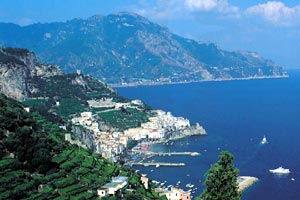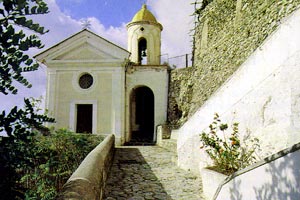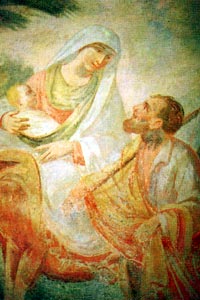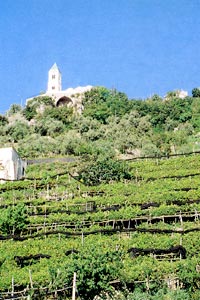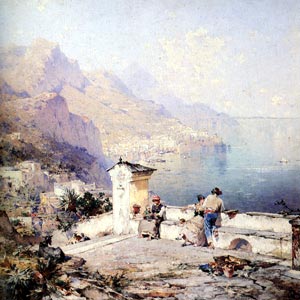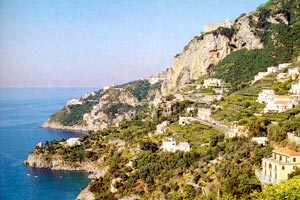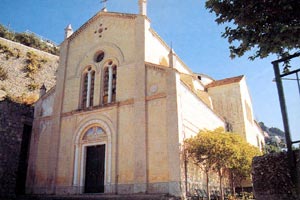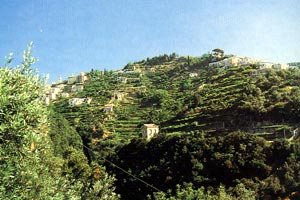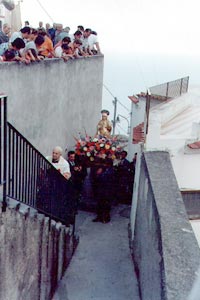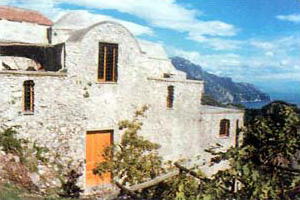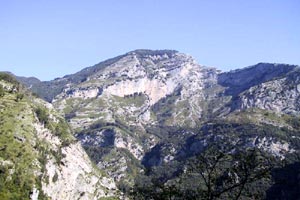| Pale Blue route » VISIT TO THE VILLAGES, TAKING THE VIA MAESTRA DEI VILLAGGI |
Time : 8 hours Difficulty: quite difficult |
| Printable Version | |
Lungomare dei Cavalieri » Passeggiata Longfellow » via Maestra dei Villaggi » Villaggio Pastena » Chiesa di S. Maria del Pino » via Maestra dei Villaggi » Villaggio Lone » Chiesa della Natività di S. Maria Vergine » via Tuoro » via Leone X » Chiesa di S. Maria Assunta » via Montetillo » via Spinale » via Pietralata » Villaggio Pogerola » via Castello » via Riulo » via Nuova per Amalfi » via Casamare
Leaving the Tourist Office we head for via lungo mare dei Cavalieri, towards the port . When we reach the play park, la Pineta, we enter and in the shadow of the majestic pines we climb the steps until we reach the top and find the path via Longfellow. We take the left and passing the small Chapel of S. Cristoforo at the end we cross the main road to the opposite side taking the via Maestra dei Villaggi… The Via Maestra dei Villaggi is an ancient footpath that connected the country villages to Amalfi, the road climbs until it reaches the village of Tovere, at a distance of about 5Km. and at 400 mt. above sea-level, passing through the villages of : Pastena, Lone and Vettica Minore… Not only important historically but also for the unique union of rural architecture, sacred buildings and the beautiful panorama. The road was much appreciated not only by the Romantic Voyagers but also by the later visitors who have left many interesting descriptions and paintings of the ambient over the centuries…we start our visit…
After several flights of steps we find the small Church of the Madonna del Carmine called St. Maria del Pino,Chapel of the noble family Lupino who had it built in the XV century. Passing through the narrow covered passage, under the bell-tower of the church, we find an fresco of the ”Flight from Egypt” by an unknown painter and we enter the heart of Pastena, the first village of Amalfi…
The name Pastena probably derives from “pastinato”, a type of agricultural contract much in use in the Middle-Ages. A formula used by the monasteries and the noble families; they gave their land to a family who were allowed to build a house and cultivate the land, giving in return the promise to take on the up-keep and the improvements to the property, planting new crops and giving a fixed part of the produce to the master…
Around us a triumph of lemon groves and terraces planted with grape vines, olives and vegetables, at about ten metres and near a large rural house we find a small fountain to refresh ourselves. On the one side ,the short via S. Caterina that joins the SS163 and the opposite side via Pomicara that climbs up to the Church dell’Assunta. We go straight ahead and passing a flight of steps arrive at a level viaduct called “mur’avete” where we can enjoy a magnificent view of Amalfi…. Going straight ahead , we pass the cross road with via Carammone on our right and the Salita Apotheca on our left, after about hundred metres we take another viaduct at the end of which is an open sided gallery suspended in the air “ a pont e Lone” much loved by eighteenth century landscape painters….
We now find ourselves in the heart of te village of Lone, beneath us the beautiful beach of Duoglio, nearby is S.Croce, and lifting up our gaze we have a magnificent view that embraces the promontory of Vettica, the sea-side village of Conca dei Marini and up on the high the monastery of St.Rosa. (Blue route).
Via Maestra dei Villaggi goes ahead until Vettica and Tovere; for us it is time to leave, taking via Tuora on the inner edge of the open space, and going up the steps we find ourselves in the large square beside the Church della Natività di S.Maria Vergine built in 1890 over the ruins of the ancient Church of S.Maria di Montevergine, erected in1204 and destroyed by a landslide at the end of the XIX century…
Along the via Tuoro (on the northern side of the square) we reach the road Papa Leone X, which we follow for about 300 metres, until we see the majestic bell-tower of the Church of St. Maria Assunta, situated below road level…
Proceeding from the porch of the Church we take to the left on via Montetillo between the luxuriant terraces of lemons. Straight ahead for about a hundred metres, passing the crossroads with via Vicinale Pomicara and then that of via Pomicara , keeping to the left we climb the ramp of steps via Spinale, going ahead until the first open space where we take via Pietralata and go on for a quarter of an hour until we reach Pogerola…
Pogerola today is a delightful village for holidays, known for the quiet atmosphere and fresh healthy air. The origins can be traced back to the ancient Castrum Pigellule.
Pigellule was a proper castle with towers and an entrance door, on the inside there were many houses and small farms, churches and monasteries. There was a fortified boundary wall from Monte Falconello, with towers and counter forts that were joined to the Castrum Scalelle on Mount Aureo (on the opposite side in conjunction with the boundary of Atrani. (Grey Route), thus closing Amalfi within one fortified boundary. The only remaining part is the tower of Pogerola, that was built in a later era, in the XV century, today it is in ruins and half hidden by the vegetation; what remains can be seen however if you follow via Sopramare until the extreme limit of the mountain…
In the centre of the square is the fifteenth century Church della Madonna delle Grazie, which holds a precious politico of the XVII century, representing “ La Madonna delle Grazie tra SS.Andrea e Gaetano”…
By the outer wall of the Church, passes the pleasant winding walk to the “Castle”, a small promontory and on the right the via Sopramare that leads to Amalfi, in the first part we find the Parochial Church of S. Marina (XII century) with an interesting portico covered with a vault in the form of a cross…
On the left of the Church we enter via Riulo that leads us to the ancient quarter of the same name and to the
Church of S. Michele Founded between 1179 and 1181, at the moment it is being restored to save what remains of some estimable frescoes of the Byzantine era. The road after about five hundred metres becomes a mountain path, that leads into the heart of the mountains of Pogerola, to Tavernata where in ancient times the via Stabiana passed, it was the main arterial road that united the territory of Amalfi with the peninsula of Sorrento…
We resist but not without difficulty the call of the woods, the sylvan vigour and fresh air of the mountains of Pogerola, to go to our right and take the wide steps of the footpath via Nuova for Amalfi, that in ample and sinuous curves follows the wooded flanks of Mount Tabor, and brings us back down to Amalfi (via Casamare) through the magnificent Valle dei Mulini…. |
| Printable Version | X
Close |
